- Home
- About Us
- Industry
- Services
- Reading
- Contact Us
Southeast Asia Battery Swapping Market: Current Analysis and Forecast (2023-2030)
Emphasis on Service Type (Pay-Per-Use, Subscription); Vehicle Type (Two-wheeler, Three-Wheeler & Four-Wheeler); Station Type (Automated, Manual);and Country
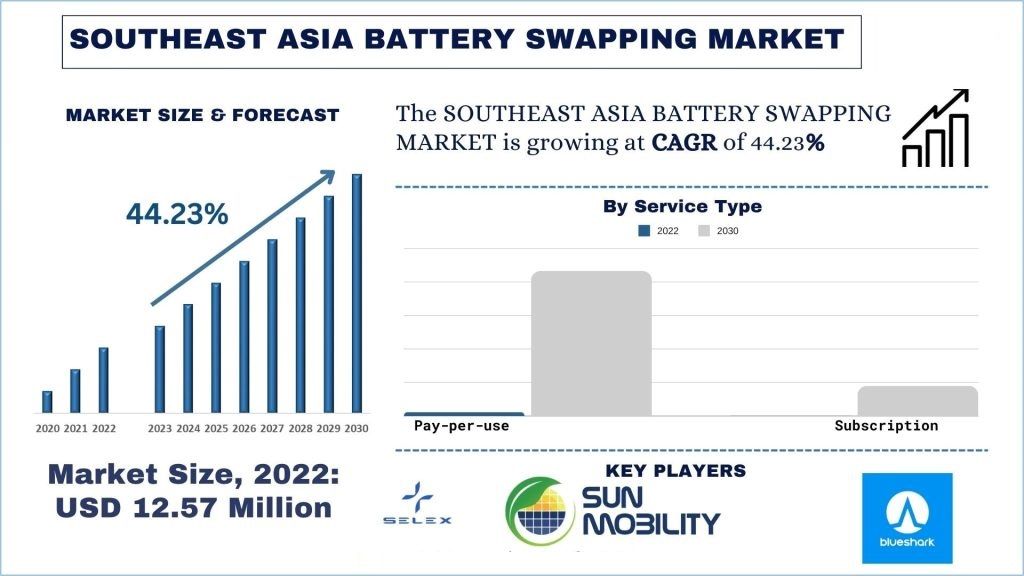
Southeast Asia Battery Swapping Market Size & Forecast
The Southeast Asia Battery Swapping Market was valued at USD 12.57 Million and is expected to grow at a strong CAGR of around 44.23 % during the forecast period (2023-2030) owing to rising demand fast charging alternatives.
Battery Swapping Market Analysis
Some of the key factors contributed to the growth were rising number of two-wheelers in the countries. As these countries have relatively poor road infrastructure as well as fall under high population density regions most of the buyers often opt for the two-wheelers for commute. This has led to a high density of two-wheelers in the region. Furthermore, with the enhanced fuel prices many of the buyers have opted for other commute alternatives for the conventional fuel options. Apart from the rising sales of electric two-wheelers timely charging has become and issue due to slow charging available in majority of the vehicles due to which many of the charging companies have started establishing battery swapping infrastructure.
These battery swapping stations are targeted at tapping the vibrant growth of electric two-wheeler market in the Southeast Asian countries..
Many of the electric vehicle battery swapping companies have announced to establish new stations in order to tap the rising growth opportunities in the Southeast Asia region. For instance, Selex Motors a Vietnamese electric vehicle manufacturer announced its plans to expand its battery swapping infrastructure in across Vietnam. In 2022, the company concluded a seed funding of USD2.1 million which has helped the company to expand its offerings in the Southeast Asia region.
In another instance, Oyika an EV charging infrastructure provider announced its plans to expand its battery swapping facilities in Cambodia and Indonesia. The company offer a no-down-payment, no-deposit, and no-contract power subscription plan that comes bundled with an e-motorbike for a weekly fee of USD 18.
Considering the rapid emergence of battery swapping stations in the Southeast Asia region the market growth is anticipated to be turbocharged in the forthcoming years i.e., 2023-2030.
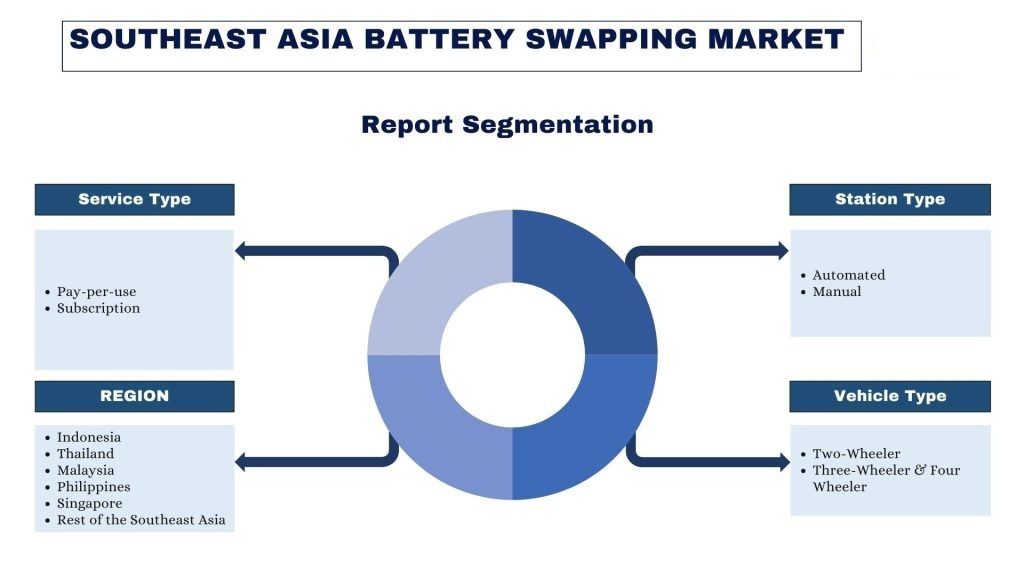 Battery Swapping Market Trends
Battery Swapping Market Trends
Transition towards Sustainable Solutions
One of the key reasons for the adoption of electric vehicles and battery swapping infrastructure is the consumer inclination towards sustainability and environmentally friendly solutions. As electric vehicle is a better alternative to conventional fuel due to lower emissions and lowered operational cost. With the zero tailpipe emissions many of the customers have shifted towards the electric vehicles. As global awareness of climate change grows, stakeholders in the region are reevaluating traditional charging practices and exploring greener alternatives. From implementing battery swapping solutions to adopting eco-friendly alternatives, battery swapping companies in the MENA region are embracing sustainability as a core tenet of their operations. Moreover, regulatory bodies are tightening environmental standards and enforcing stricter compliance measures, prompting conventional vehicle manufacturers to invest in cleaner technologies and undertake comprehensive environmental impact assessments.
Indonesia Dominated the Battery Swapping Market
Indonesia is one of the largest economies in the Southeast Asia region that has a high market for two-wheelers and four-wheelers. Many of the factors have supported the growth of battery swapping market in Indonesia. In the historical years the demand for electric vehicles in the country has extensively increased due to which a large number of companies have moved to improve the charging as well as battery swapping infrastructure. By 2022, Indonesia had 439 EV charging stations and 961 battery swap stations, most of them located in urban areas like Java and Jakarta. This number is further anticipated to grow as the sales of electric vehicles in the country has enhanced significantly.
The charging stations and battery swapping stations in the country would grow in a noticeable number as per the government plans. As per the government plans to install 31,859 charging stations as well as 67,000 battery swapping stations. However, the electric vehicles are majorly charged in homes, the trend is slowly being changed with improving road infrastructure.
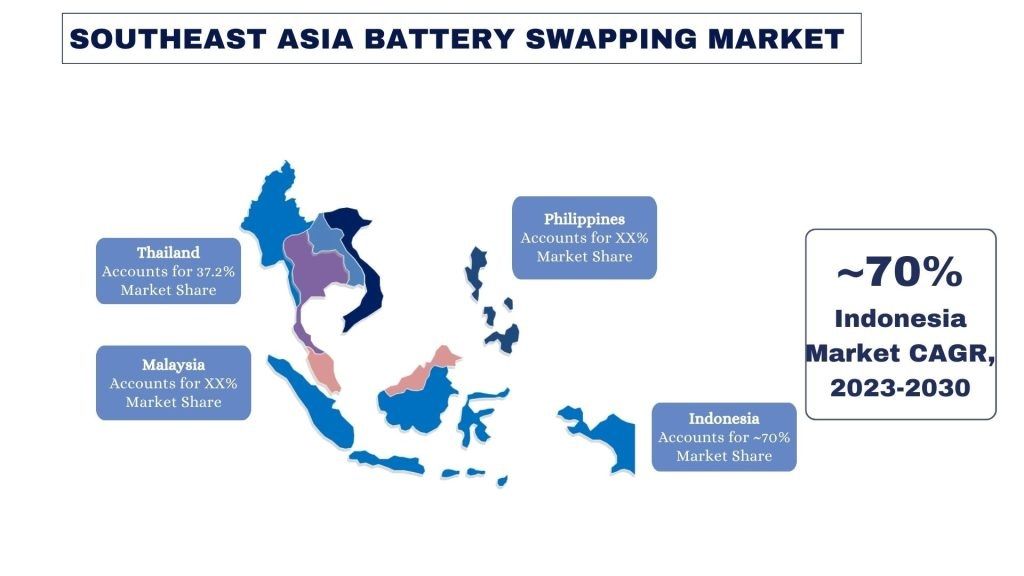
Battery Swapping Industry Overview
The Battery Swapping market is competitive and fragmented, with the presence of several Southeast Asia and international market players. The key players are adopting different growth strategies to enhance their market presence, such as partnerships, agreements, collaborations, new product launches, geographical expansions, and mergers and acquisitions. Some of the major players operating in the market are Selex Motor, Blueshark, Sun Mobility, Oyika, Onion Mobility Solutions, Gogoro Inc., Pertamina, Winnonie, Honda PCX Battery Smart, H SEM Power Station, Swap and go, ETRAN Power Station, EGAT, ZHI EV Station, MaCharge, and Batt Swap.
Battery Swapping Market News
- In 2023, a Taiwanese two-wheeler manufacturer Kymco announced its partnership with the Arun Plus for an existing battery swapping scooter network in Bangkok called Swap & Go on its website for both pay-per-use and subscription model.
- In 2023. Oyika a battery swapping provider launched its battery-as-a-service market in Thailand, Malaysia, Cambodia and Indonesia. The company’s battery design makes it compatible, with majority of the mass-market electric motorcycles in the Southeast Asia region, while providing affordable power subscription packages, bundling battery swaps and electric motorcycles.
- In 2022, ONiON Mobility one of the ev manufacturing companies in the Southeast Asia region unveiled its ONiON T1C (three-wheeler). The vehicle is developed for commercial operations in the Southeast Asian markets.
- In 2021, Honda Motors along with three other automotive manufacturers have announced to develop standardized interchangeable batteries for electric two-wheeler. These companies include Yamaha Motors, Kawasaki Heavy Industries, and Suzuki Motors along with Honda Motors.
Battery Swapping Market Report Coverage
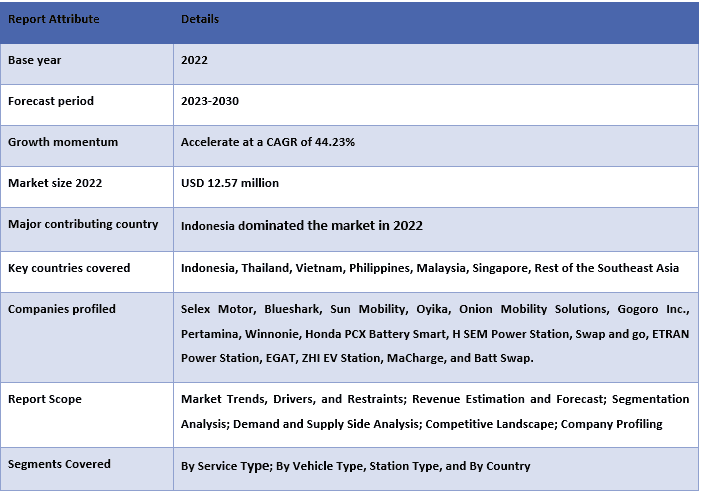
Reasons to buy this report:
- The study includes market sizing and forecasting analysis validated by authenticated key industry experts.
- The report presents a quick review of overall industry performance at one glance.
- The report covers an in-depth analysis of prominent industry peers with a primary focus on key business financials, product portfolios, expansion strategies, and recent developments.
- Detailed examination of drivers, restraints, key trends, and opportunities prevailing in the industry.
- The study comprehensively covers the market across different segments.
- Deep dive regional level analysis of the industry.
Customization Options:
The Southeast Asia Battery Swapping market can further be customized as per the requirement or any other market segment. Besides this, UMI understands that you may have your own business needs, hence feel free to contact us to get a report that completely suits your requirements.
Table of Content
Research Methodology for the Southeast Asia Battery Swapping Market Analysis (2023-2030)
Analyzing the historical market, estimating the current market, and forecasting the future market of the Southeast Asia Battery Swapping market were the three major steps undertaken to create and analyze the adoption of Battery Swapping in major countries in Southeast Asia. Exhaustive secondary research was conducted to collect the historical market numbers and estimate the current market size. Secondly, to validate these insights, numerous findings and assumptions were taken into consideration. Moreover, exhaustive primary interviews were also conducted, with industry experts across the value chain of the Southeast Asia Battery Swapping market. Post assumption and validation of market numbers through primary interviews, we employed a top-down/bottom-up approach to forecasting the complete market size. Thereafter, market breakdown and data triangulation methods were adopted to estimate and analyze the market size of segments and sub-segments of the industry pertains to. Detailed methodology is explained below:
Analysis of Historical Market Size
Step 1: In-Depth Study of Secondary Sources:
Detail secondary study was conducted to obtain the historical market size of the Battery Swapping market through company internal sources such as annual reports & financial statements, performance presentations, press releases, etc., and external sources including journals, news & articles, government publications, competitor publications, sector reports, third-party database, and other credible publications.
Step 2: Market Segmentation:
After obtaining the historical market size of the Battery Swapping market, we conducted a detailed secondary analysis to gather historical market insights and share for different segments & sub-segments for major regions. Major segments are included in the report type and application. Further country-level analyses were conducted to evaluate the overall adoption of testing models in that region.
Step 3: Factor Analysis:
After acquiring the historical market size of different segments and sub-segments, we conducted a detailed factor analysis to estimate the current market size of the Southeast Asia Battery Swapping market. Further, we conducted factor analysis using dependent and independent variables such as type and application of the Battery Swapping market. A thorough analysis was conducted for demand and supply-side scenarios considering top partnerships, mergers and acquisitions, business expansion, and product launches in the Battery Swapping market sector across the Southeast Asia.
Current Market Size Estimate & Forecast
Current Market Sizing: Based on actionable insights from the above 3 steps, we arrived at the current market size, key players in the Southeast Asia Battery Swapping market, and market shares of the segments. All the required percentage shares split, and market breakdowns were determined using the above-mentioned secondary approach and were verified through primary interviews.
Estimation & Forecasting: For market estimation and forecast, weights were assigned to different factors including drivers & trends, restraints, and opportunities available for the stakeholders. After analyzing these factors, relevant forecasting techniques i.e., the top-down/bottom-up approach were applied to arrive at the market forecast for 2030 for different segments and sub-segments across the major markets in Southeast Asia. The research methodology adopted to estimate the market size encompasses:
- The industry’s market size, in terms of revenue (USD) and the adoption rate of the Battery Swapping market across the major markets domestically
- All percentage shares, splits, and breakdowns of market segments and sub-segments
- Key players in the Southeast Asia Battery Swapping market in terms of products offered. Also, the growth strategies adopted by these players to compete in the fast-growing market.
Market Size and Share Validation
Primary Research: In-depth interviews were conducted with the Key Opinion Leaders (KOLs) including Top Level Executives (CXO/VPs, Sales Head, Marketing Head, Operational Head, Regional Head, Country Head, etc.) across major regions. Primary research findings were then summarized, and statistical analysis was performed to prove the stated hypothesis. Inputs from primary research were consolidated with secondary findings, hence turning information into actionable insights.
Split of Primary Participants in Different Countries
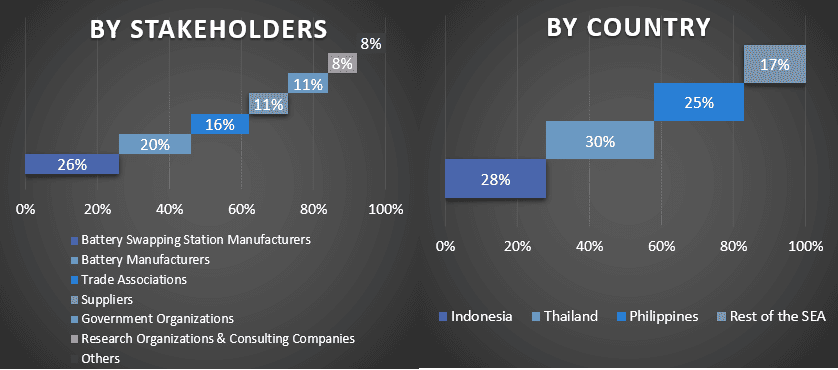
Market Engineering
The data triangulation technique was employed to complete the overall market estimation and to arrive at precise statistical numbers for each segment and sub-segment of the Southeast Asia Battery Swapping market. data was split into several segments & sub-segments post studying various parameters and trends in the areas of the service type, vehicle type and station type in the Southeast Asia Battery Swapping market.
The main objective of the Southeast Asia Battery Swapping Market Study
The current & future market trends of the Southeast Asia Battery Swapping market were pinpointed in the study. Investors can gain strategic insights to base their discretion for investments on the qualitative and quantitative analysis performed in the study. Current and future market trends determined the overall attractiveness of the market at a regional level, providing a platform for the industrial participant to exploit the untapped market to benefit from a first-mover advantage. Other quantitative goals of the studies include:
- Analyze the current and forecast market size of the Southeast Asia Battery Swapping market in terms of value (USD). Also, analyze the current and forecast market size of different segments and sub-segments.
- Segments in the study include areas of the service type, vehicle type and station type.
- Define and analysis of the regulatory framework for the Battery Swapping
- Analyze the value chain involved with the presence of various intermediaries, along with analyzing customer and competitor behaviors of the industry.
- Analyze the current and forecast market size of the Battery Swapping market for the major region.
- Major countries of regions studied in the report include Indonesia, Thailand, Vietnam, Malaysia, Philippines, Singapore and Rest of the Southeast Asia.
- Company profiles of the Battery Swapping market and the growth strategies adopted by the market players to sustain in the fast-growing market.
- Deep dive country level analysis of the industry
Frequently Asked Questions FAQs
Q1: What is the current market size and growth potential of the Southeast Asia Battery Swapping Market?
Q2: What are the driving factors for the growth of the Southeast Asia Battery Swapping Market?
Q3: Which segment has the largest share of the Southeast Asia Battery Swapping Marketby station type?
Q4: What are the emerging technologies and trends in the Southeast Asia Battery Swapping Market?
Q5: Which country will dominate the Southeast Asia Battery Swapping Market?
Related Reports
Customers who bought this item also bought










